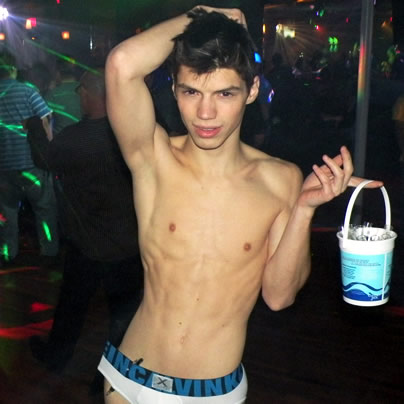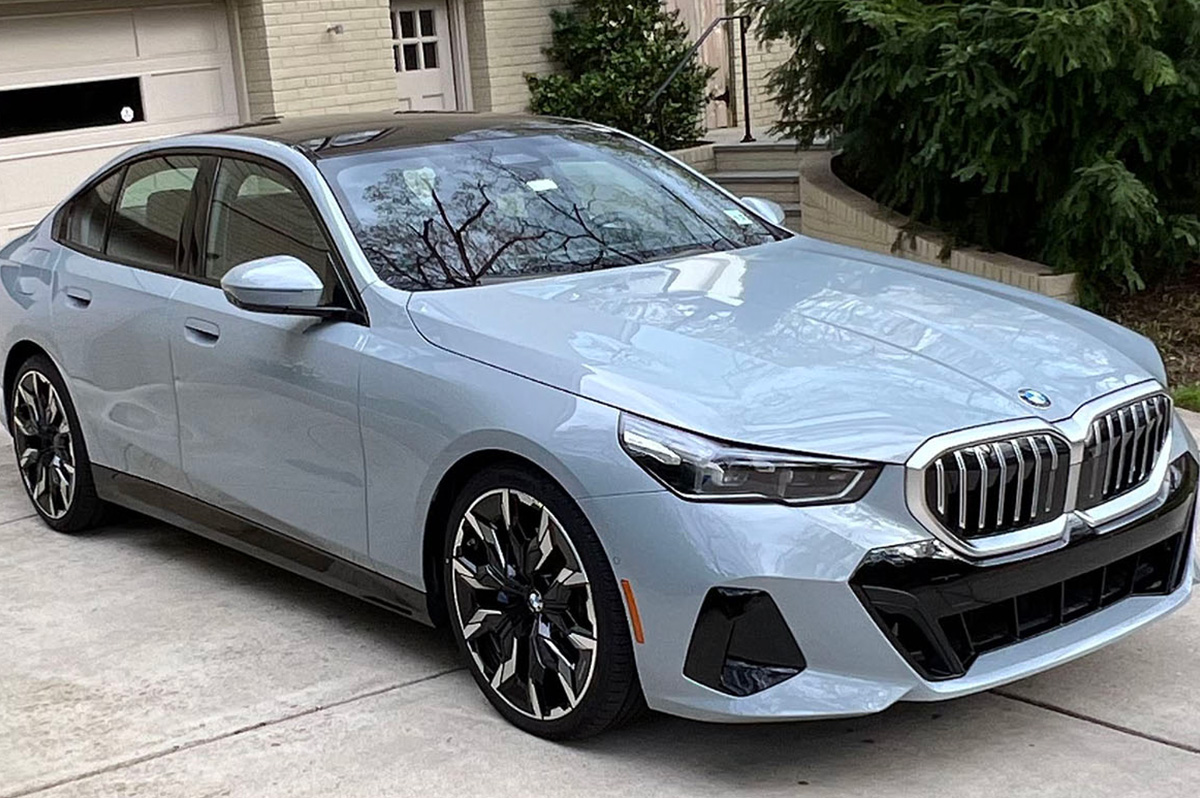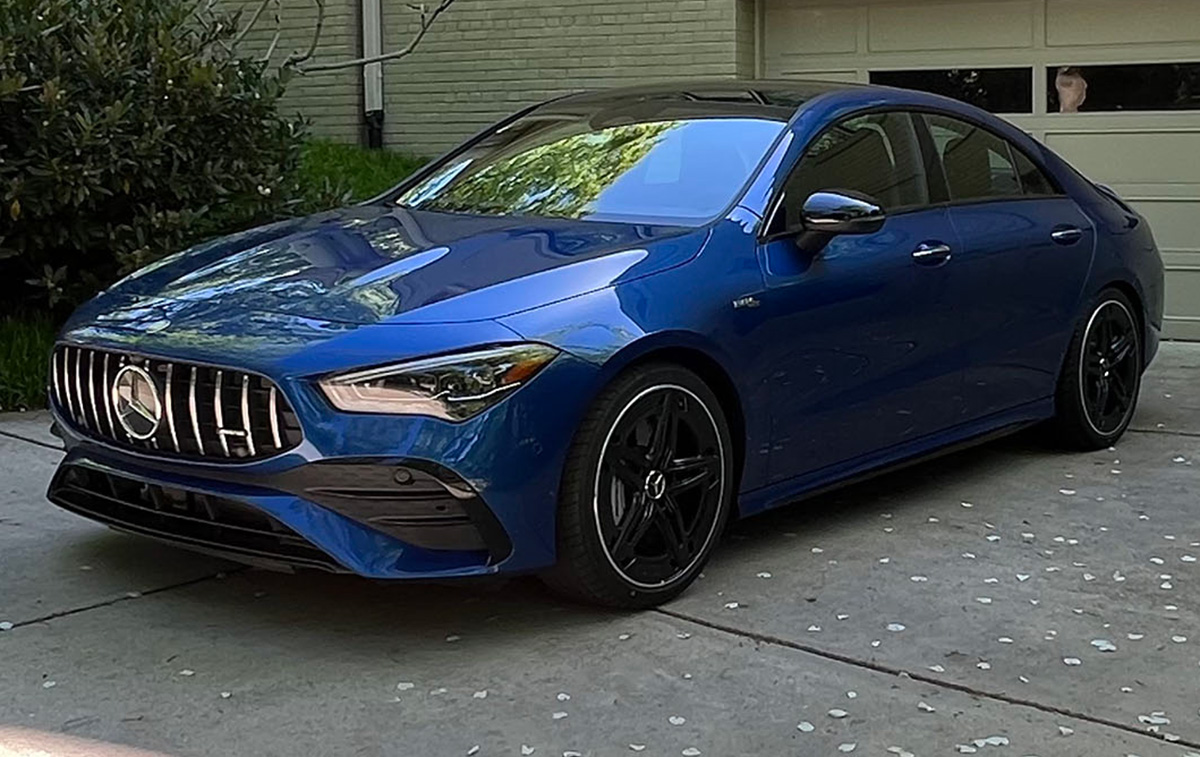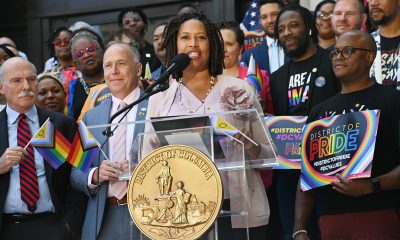Living
Country roads, take me home
New W.Va. gay club hopes to succeed where others nearby have failed


A recent night at The Club, a new gay bar in Martinsburg, W.Va. (Photo by Dale Gish)
MARTINSBURG, W.Va. — Gay-popular entertainment districts are almost always found in major metropolitan areas, but there’s a smattering of clubs and restaurants in the close-by regions of Maryland’s Cumberland Valley and West Virginia’s Eastern Panhandle that are drawing decent-sized crowds despite being more than an hour from either Washington or Baltimore.
For decades, The Lodge in Boonsboro, Md., has been pretty much the only gay nightclub in the region. Formerly known as Deer Park Lodge and at times closed altogether, it’s been thriving again under new management since 2011 when partners Ryan Dryden and Joe Velazquez moved from Washington to reopen and run it.
Since January, it’s faced some competition as The Club (theclubwv.com), a new gay bar/club in Martinsburg, W.Va.’s Spring Mills area (about 21 miles from The Lodge), took over a large spot formerly known as straight bars Ambitions and before that, Gatsby’s. Owner Coby Myers, a gay sheriff in West Virginia, has his gay friends Jarvis Jerry Brooks and Dale Gish running the operation. They say, so far, business has been good and that they’re carving out a niche for themselves in the region by offering strong customer service, a “family”-type atmosphere and a clean and newly remodeled space. It’s about 80 miles from Dupont Circle.
“A lot of people feel it’s just easier to get instant gratification now on the Internet,” says Brooks, who DJs at The Club in addition to booking talent and planning events. “I think my thing is just that a lot of clubs have forgotten the whole aspect of a family feel, where everybody knows your name and there’s a home bar feel to it. You’re not just a number, you’re not just a door cover, there’s more to it than that.”
But can it last? Are there enough LGBT residents in these parts of Maryland and West Virginia to support two small-town gay clubs? A few others have come and gone in recent years. The Mariner Club, locals say, had a decent run for a few years on Martinsburg’s Winchester Ave. It was across the street from Sugar Daddy’s, a male strip club that, although not technically gay, had gay strippers and more gay male patrons than straight women. But both are now closed.
And more recently Spin/Club Underground, which was in downtown Hagerstown just a few doors down from the historic Maryland Theatre, died a relatively quick death after being open less than a year. Brooks, who DJed at the gay club (his DJ name is Jerrbear), says business was “hit and miss.”
Those involved say they see a brighter future for The Club.
“For one thing, it’s not mismanaged,” says Ray Stagner, a drag queen who performs as Cheyenne and who debuted at The Club last Saturday night.
Wearing full drag makeup but dressed in a ball cap, jeans and guy’s T-shirt while puffing on a cigarette in The Club’s downstairs smoking-allowed pool room, Stagner, a Hagerstown resident, says gays and drag performers in the region will support both The Club and The Lodge. Because of liquor laws, The Club can stay open an hour later (until 3 a.m.) on Saturday nights whereas the Lodge closes at 2.
“I think it’s great,” Stagner says. “If people want to go here one night they can, or they may do like we used to do in the old days. As soon as they called last call at Deer Park, we used to bail from Hagerstown and come down here to Gatsby’s once they closed the bars in Hagerstown.”
Last Saturday night at about 10 p.m., The Club had a healthy crowd though it wasn’t packed. The space is mammoth — there’s a large dance area, stage, bar, tables, seating area, downstairs pool room, kitchen and a huge outdoor patio and bar Brooks says they “can’t wait” to use once the weather gets warmer.
“It reminds me of the old Tracks in D.C.,” he says. “There’s so much potential for this space.”
All the interiors have been redecorated since it was Ambitions. The hardwood dance floor, Brooks says, is the one original component — it dates to the 1950s.
A diverse crowd mills about including 20- and 30-ish gay guys, a few older gay men, a few lesbians and a drag queen or two. A few dance, but not many. It’s still early. Several make trips up and down the half-flight of stairs to take smoke breaks. The pool room is less opulent, but the smokers don’t seem to mind. Large industrial smoke eaters keep the room clean and from upstairs it’s impossible to tell there’s smoke in the building.
Gish says the region is large enough that gays are coming from Winchester, Va.; Cumberland, Md.; even Greencastle and Chambersburg, Pa., and that The Club will thrive. Gays from Baltimore or D.C. who want a change of scenery even visit on occasion, he says.
“We’re seeing our weekend door counts increase every weekend,” Gish says. “I think it will only improve as the weather warms.”
There are about 12 on staff but DJs and drag performers are independent contractors. Brooks says they’re seeing about 200 come through the doors on an average Saturday night. A few times it’s gotten close to 300. It’s open Wednesday through Saturday and on weekends there’s a $5 cover. Eighteen-to-20-year-olds can get in anytime but have to pass Breathalyzer tests when they come and go. Gish guesses about 20 percent of the clientele might be “some variation of straight” and says the crowd, because of the smaller overall numbers, is more integrated than in city bars. He says straights, lesbians, bears and twinks all party together here.
Despite rumors of bad blood between The Club and The Lodge, the owners of the latter say they bear no ill will.
“It’s really not a question of competition, it doesn’t matter how many there are in the area, there are more than enough [LGBT people] to go around,” Velazquez says. “So far business has stayed good for us and been pretty good for them. Whether it stays that way, time will tell.”
He says there are even some unexpected benefits at times.
Of The Lodge’s drag cast, Velazquez says he encourages them to perform at other bars.
“They get fans who will then follow them from show to show and we have some people who only show up for the drag shows, so it’s good for them to be out at different bars in the area,” he says. “I have no problem with it. It’s a free world. If I wanted to have them sign an exclusivity contract, I would, but we don’t.”
There are also a few gay-owned restaurants in the region — the Gourmet Goat and Georgia Boys Café in Hagerstown, and Café Izmir in nearby Funkstown, Md.
The Goat, (41 North Potomac Street), has been in its present location for seven years and is known for its vast array of martinis. Owners Steve Cook and Paul Deputy live on site and run it “very much hands on,” Deputy says.
Café Izmir is owned by Nihal Mizah, who’s straight. The cafe became an LGBT destination of sorts during the time The Lodge was closed. Lesbian Karla Auch helps her manage it.
Gish says he thinks it’s more than a coincidence. Although these areas, he says, will never have the large gay communities Baltimore and Washington have, there are LGBT people here and he says they’re more comfortable being out and open than they were even a decade ago.
“I think there’s a social change happening,” he says. “And not just in the media, but in families too and the culture in general. It’s becoming more accepted to be gay and be open about it, or lesbian, or bi or trans or whatever you are. Society is becoming more accepting and these business owners want to pursue their dreams without feeling that they’re going to be persecuted. I know all these business owners and I support them all and wish them the best.”
Autos
Sporty sedans: BMW 530i xDrive, Mercedes AMG CLA 3
Tariffs are here and the result is financial chaos

It’s official: Tariffs are here, and the result is financial chaos.
So, what to do when purchasing a new vehicle? If you need one in the not-so-distant future, buy sooner (like yesterday) rather than later. Expect prices to rise quickly, as inventory dwindles, demand soars, and automaker incentives evaporate. Of course, if a new ride isn’t a priority for at least a year or three, then hold off until the dust settles.
But for those of you looking for new wheels now, I recently drove two sport sedans that were a pleasant reprieve from the usual plethora of pickups, minivans, and SUVs.
BMW 530i xDRIVE
$63,000
MPG: 28 city/35 highway
0 to 60 mph: 5.5 seconds
Cargo space: 18.4 cu. ft.
PROS: Rakish looks. Race-car vibe. Rock-star amenities.
CONS: Rad-but-quirky infotainment system. Rich price.
IN A NUTSHELL: Classic good looks, from the iconic grille and swept-back headlights to chiseled side panels and a tasteful tush. For a gearhead like me, the BMW 530i xDrive — completely redesigned last year — is as rapturous as Michelangelo’s David. Everything here is in proportion, from the design to the drivetrain, which — along with a gutsy 255-hp turbo and all-wheel drive — helps deliver a divine experience behind the wheel. Even better, my test car came equipped with the heavenly M-Sport Package: 21-inch wheels, athletic suspension, and assorted styling upgrades.
A tech-laden cabin is outfitted with a sparkly 12.3-inch digital instrument cluster and 14.9-inch touchscreen infotainment system. With the windshield head-up display and a slew of knobs and toggle switches in the center console and on the steering wheel, I wondered if this is how it feels to pilot the Space Shuttle. There is even a back-lit interaction bar with touch-sensitive controls to adjust vent direction and other climate control settings.
All this gadgetry takes some getting used to, but the overall effect is dazzling. While a 12-speaker Harman Kardon stereo comes standard, I was jammin’ to the 16-speaker Bowers & Wilkins premium audio. Of course, such options add up quickly (on my test car, the extras totaled $13,000).
Just how fun is this car? In my favorite episode of “Hacks,” sassy Jean Smart drives a rockin’ Rolls Royce Wraith. Trust me, this four-door BMW is every bit the badass as that $300,000 super coupe.
MERCEDES AMG CLA 35

$58,000
MPG: 22 city/29 highway
0 to 60 mph: 4.8 seconds
Cargo space: 11.6 cu. ft.
PROS: Slick styling. Spiffy cabin. Sublime seats.
CONS: Smallish trunk. So-so rear headroom and legroom.
IN A NUTSHELL: Need a smaller sedan that’s just as marvy as the midsize BMW i530? Look no further than the compact Mercedes CLA-Class, which is 14 inches shorter. That’s a benefit when jockeying for parking or navigating rush hour.
Another plus: This is Mercedes’s least expensive sedan, available in three trim levels. All come with the same potent turbo but in varying power levels. The base model starts at $46,000, but I tested the first of two high-performance versions: the AMG CLA 35, which costs $12,000 more. You can open your wallet even further to snag the $67,000 AMG CLA 45.
But why bother? The AMG CLA 35 is plenty quick — faster than the BMW i530 — and boasts sport-tuned brakes, deft handling and a gritty-sounding exhaust system. The laundry list of standard features includes all-wheel drive, automated parking, gobs of the latest safety gizmos and even something called “safe-exit assist,” which prevents passengers from opening a door into traffic or speeding cyclists.
The interior is pure Mercedes, with top-notch materials, customizable ambient lighting and Burmester surround-sound audio. The overall layout—sleek and modern, but with elegant stitching in the seats and on the door panels and dashboard—is comfortable and user-friendly. Digital displays and touchscreens are similar to what’s in the BMW i530, just smaller.
Size matters, of course, which is why this vehicle’s shorter length can be a blessing but also a curse, especially when trying to squeeze passengers with longer legs into the backseats. And the dramatically sloped roofline, attractive from the outside, limits the amount of rear headroom and cargo space. Thank the automotive gods for panoramic sunroofs, which—at least for anyone in the front seats—makes this cabin feel surprisingly spacious.
Real Estate
Spring updates to sell your home for pride and profit
Consider new landscaping, power washing, creative staging

Selling a home is a big deal for anyone, but for members of the LGBTQ+ community, it comes with unique considerations—from finding affirming professionals to ensuring your home is represented in a way that reflects your values. Whether you’re a first-time gay home seller or a seasoned LGBTQ+ homeowner looking to move up, maximizing your home’s value is key to a successful and empowering sale.
Here’s how to prepare your home, your mindset, and your real estate strategy to get the most value—financially and emotionally—from your home sale.
1. Start with an LGBTQ+-Friendly Real Estate Agent
Before diving into renovations or staging, make sure your agent truly understands your needs. A gay-friendly or LGBTQ+-affirming real estate agent brings more than just market expertise—they bring cultural competence, safety awareness, and a network that supports you throughout the selling process.
At GayRealEstate.com, you can find experienced, vetted LGBTQ+ real estate agents who have been proudly serving the community for over 30 years. Working with someone who shares or supports your identity ensures your selling journey is respectful, inclusive, and effective.
2. Enhance Curb Appeal—With a Welcoming Vibe
The outside of your home is the first impression a potential buyer gets. Make it count—especially for LGBTQ+ buyers looking for a home that feels safe and welcoming.
- Fresh landscaping: Add colorful flowers, neatly trimmed shrubs, or low-maintenance greenery to appeal to eco-conscious buyers.
- Update the entrance: A new front door, stylish lighting, or even a rainbow doormat can make your home feel like a safe space from the start.
- Clean and repair: Power wash the exterior, touch up paint, and make any necessary repairs to gutters, windows, or siding.
3. Stage with Intention and Inclusivity
Home staging can add thousands to your sale price. But beyond the usual decluttering and neutral palettes, think about how your space tells a story—and who it’s telling it to.
- Create a warm, inclusive feel: Subtle touches like LGBTQ+ art, books, or even coffee table magazines can show off your personality and affirm the space for queer buyers.
- Depersonalize—but don’t erase: You don’t need to hide your identity to appeal to buyers. Let your home feel lived in and loved—while still being a blank canvas others can imagine themselves in.
- Highlight multi-use areas: Home offices, gender-neutral nurseries, or flex spaces resonate with LGBTQ+ families and professionals.
4. Update Kitchens and Bathrooms Strategically
These rooms matter most to buyers—and even small updates can yield big returns.
- Kitchen: New cabinet hardware, a fresh backsplash, and modern lighting can elevate the entire room without a full remodel.
- Bathroom: Replace old fixtures, re-caulk tubs and sinks, and add plush towels and inclusive décor.
- Energy-efficient upgrades: Touchless faucets, smart appliances, or low-flow toilets are not only trendy—they signal sustainability, which matters to LGBTQ+ buyers.
5. Make Your Home More Energy Efficient
LGBTQ+ homebuyers often prioritize sustainability. These updates not only reduce energy bills but make your home more marketable.
- Install a smart thermostat (like Nest or Ecobee)
- Upgrade insulation or windows
- Consider solar panels (especially in sun-drenched regions like California or Florida)
Bonus: You may qualify for state or federal tax credits, which can be a great selling point.
6. Know and Advocate for LGBTQ+ Housing Rights
Although housing discrimination is illegal under the Fair Housing Act, it still happens. As an LGBTQ+ seller, be aware of your rights—and those of potential buyers.
- Avoid steering or bias: Even with good intentions, make sure you’re not inadvertently influencing who views or buys your home based on identity.
- Work with affirming professionals: From inspectors to lenders, choose partners who support inclusive practices.
- Report discrimination: If you or a buyer encounters bias, report it to HUD or your local housing authority.
7. Price Your Home Right—and Market It Smartly
Setting the right price is essential to maximizing value. Your LGBTQ+-friendly agent can run a comparative market analysis, considering current trends and buyer demographics.
- Leverage LGBTQ+ real estate networks: Promote your home through platforms like GayRealEstate.com to reach an audience that understands and values your space.
- Use inclusive language in listings: Avoid gendered terms or heteronormative assumptions. Instead of “his and hers closets,” use “dual walk-ins” or “double closets.”
- High-quality photos and video tours: Showcase your home with professional, visually inclusive marketing that appeals to diverse buyers.
8. Consider Timing and Local LGBTQ+ Trends
Selling during WorldPride or just before local LGBTQ+ events may boost visibility. Also consider if you’re in or near an LGBTQ+ friendly city or neighborhood.
Not sure which areas are top destinations? GayRelocation.com tracks and shares the best cities for LGBTQ+ homebuyers, helping you tap into motivated buyers.
Final Thought: Sell with Confidence—and Community
Selling your home isn’t just about getting top dollar—it’s about closing a chapter with pride and integrity. When you center your values, work with LGBTQ+ affirming experts, and prepare your home with purpose, you’re not just maximizing your home’s value—you’re creating an empowering experience for yourself and the next owner.
Whether you’re buying, selling, or both—GayRealEstate.com is your trusted partner in every step of your journey. With a nationwide network of gay and lesbian realtors, decades of experience, and deep community ties, we ensure your home transition is safe, smart, and full of pride.
GayRealEstate.com is the nation’s leading online platform connecting LGBTQ+ home buyers and sellers with LGBTQ+ friendly real estate agents, ensuring a safe and supportive experience.
Scott Helms is president of GayRealEstate.com. To find an agent or learn more, visit GayRealEstate.com, GayRelocation.com or call 1-888-420-MOVE.
Real Estate
Navigating DMV real estate market during political unrest
Reductions in federal employment have introduced uncertainties

The Washington, D.C.-Maryland-Virginia (DMV) region has long been recognized for its robust housing market, underpinned by the presence of the federal government and a diverse economic landscape. Recent massive reductions in federal employment have introduced uncertainties, yet the area continues to offer compelling reasons for prospective homebuyers, particularly within diverse communities.
While the federal government has traditionally been a significant employer in the DMV, the region has proactively diversified its economic base. Sectors such as technology, professional services, education, and healthcare have expanded, mitigating the impact of federal job cuts. This diversification fosters some economic resilience, which offers our area a semblance of protection against the impending unknowns that we currently face. Nothing can shield real estate entirely; however, our area tends to survive these types of changes better than other parts of the country.
Despite concerns over federal layoffs, the DMV housing market has demonstrated notable stability. Analyses indicate that the number of active listings, sold properties, and median sales prices have remained steady on a year-over-year basis. This steadiness suggests that the market is adapting to changes without significant disruption.
Furthermore, while there has been a slight increase in home listings, this trend aligns with typical seasonal variations and does not solely reflect federal employment changes. The luxury property segment, in particular, continues to thrive, indicating sustained interest and investment in the region.
The DMV region is renowned for its cultural and demographic diversity, with areas like Montgomery County, Md., being among the most ethnically diverse in the nation. This inclusivity extends to various communities, including LGBTQ individuals, fostering a welcoming environment that enhances the area’s appeal. Even though the current administration is fostering anti-diversity ideology, I remain confident that our LGBTQ community will continue to thrive even as these destructive forces work against us.
Local governments within the DMV have implemented policies aimed at promoting affordable housing and preventing displacement, particularly in the wake of economic shifts. Initiatives like the Douglass Community Land Trust in Washington, D.C., exemplify efforts to maintain housing affordability and support community stability.
Additionally, jurisdictions such as Montgomery County have longstanding Moderately Priced Dwelling Unit (MPDU) programs that require developers to include affordable housing in new residential developments. These policies contribute to socioeconomically mixed neighborhoods, benefiting diverse populations.
Despite Elon Musk’s brandishing of a chainsaw to the federal workforce, our real estate market continues to thrive. The DMV region maintains its appeal. Economic diversification, market stability, commitment to diversity and inclusion, and progressive housing policies collectively contribute to an environment that supports and attracts diverse communities. Prospective homebuyers can find reassurance in the region’s resilience and ongoing efforts to foster an inclusive and vibrant community. These are only a few among the many reasons to have a positive outlook while considering real estate options in our area.
It is important to consider working with brokerages, brokers, agents, lenders and title companies who align with our community and our objectives. Not all LGBTQ agents work for brokerages that support or understand the needs of the members of our community. Do your research and find out who has donated money to what political causes. Now more than ever we must support members of our community to protect our way of life and our very existence.
Stacey Williams-Zeiger is president/principal broker of Zeiger Realty Inc. Reach her at [email protected].
-

 State Department4 days ago
State Department4 days agoHIV/AIDS activists protest at State Department, demand full PEPFAR funding restoration
-

 Brazil4 days ago
Brazil4 days agoUS lists transgender Brazilian congresswoman’s gender as ‘male’ on visa
-

 District of Columbia4 days ago
District of Columbia4 days agoCapital Pride wins $900,000 D.C. grant to support WorldPride
-

 Mexico3 days ago
Mexico3 days agoGay couple claims Puerto Vallarta wedding venue discriminated against them










